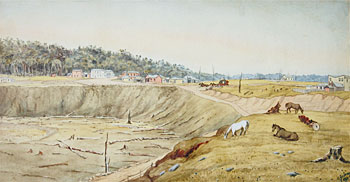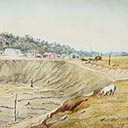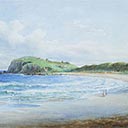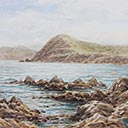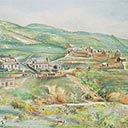Eketahuna
35 x 66 cm
est. $18,000 - 25,000
Eketahuna, as a European settlement, owes its origins to Sir Julius Vogel's Immigration and Public Works Act of 1870 which initiated a new wave of colonisation. Some 7,500 new arrivals, the majority from Scandinavia, landed in New Zealand by the middle of 1873. Vogel's scheme was essentially to open up the hinterland of the country by the clearing of the bush, and the building of new roads, bridges and railways.
Those who first settled in Eketahuna were mostly Swedish. They arrived in Wellington on the 'Forfarshire' on 4th March 1873 and, after a brief period of rest at the immigration barracks, made their way over the Rimutakas to Kopuaranga north of Masterton, where a camp had been established by earlier Scandinavian arrivals. These were mostly Norwegian, Danish and some Germans. Living conditions in this temporary accommodation were crowded, primitive and unhygienic but there they had to stay since their promised new home at the Eketahuna Block, some 35 kilometres north, had not been surveyed.
It was in October 1873 that four of these hardy God-fearing Lutheran immigrants, Nis Lund and Anders Olsen, each with wife and child, Berndt Syversen with wife and three children and Anders Andersen without his wife who had remained behind at Kopuaranga as she was expecting a child, made their way to Waiwaka, three kilometres south of the present township. There they found a derelict surveyor's hut which they made weatherproof and which became their 'home' until the men had completed the stretch of road to the Eketahuna Block. They were joined by other Scandinavian helpers including Alex Jacobsen who found no spare room so he and his wife improvised accommodation in a hollow hinau log with a canvas sheet over one end. It at least kept the elements from them! The Jacobsen's daughter, Annie Louise, (later Mrs Hardingham) was the first white child born in Eketahuna - on 29th January 1875.
The settlers called their new home Mellemskov which means, 'Heart of the Forest' and maps of the 1870s give this name for the settlement. However, by the end of the seventies the name had reverted to the Maori one of Eketahuna which means, 'to run aground on a sandbank'; so named by the 'tangata whenua' to describe that location where their waka or canoes could travel no further up the Makakahi River, which bisects the township. Peter Best
Reproduced courtesy www.eketahunakiwicountry.co.nz

